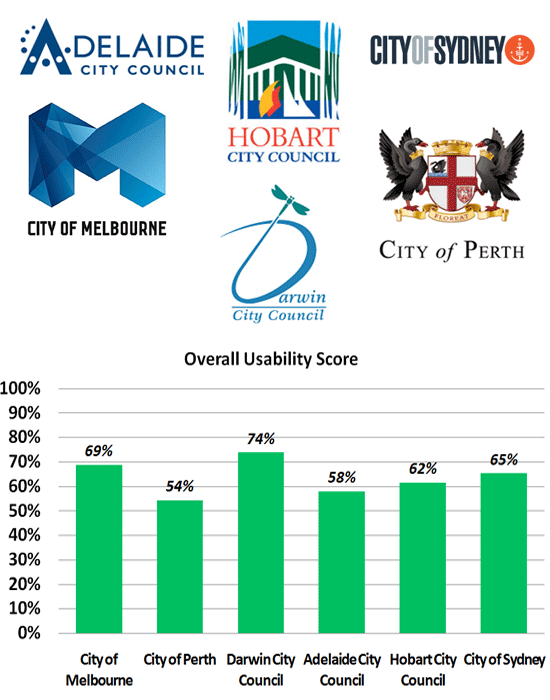
Which City Council has the best website?
We took six of Australia’s capital city councils and tested the usability of their websites. You'll be surprised by which council came out on top.
Understand user behavior on your website.
Test usability on mobile devices and tablets.
Conduct live, guided user testing sessions.
Design or refine your information architecture.
Allow users to test without assistance.
Understand visitors’ goals and satisfaction.
Determine which design performs better.
Analyze your website against competitors.
Optimize design before development.
Measure ease of finding your online properties.
Gain deeper insights using the power of AI.
Track users’ clicks and navigation patterns.
Visualize user engagement and interaction.
Capture user interactions for usability analysis.
Get access to all Loop11 features for free. Start free trial
Understand user behavior on your website.
Test usability on mobile devices and tablets.
Conduct live, guided user testing sessions.
Design or refine your information architecture.
Allow users to test without assistance.
Understand visitors’ goals and satisfaction.
Determine which design performs better.
Analyze your website against competitors.
Optimize design before development.
Measure ease of finding your online properties.
Gain deeper insights using the power of AI.
Track users’ clicks and navigation patterns.
Visualize user engagement and interaction.
Capture user interactions for usability analysis.

Gain a competitive advantage with comparative benchmarking

Run user studies on both your own and competitors websites

Test the market demand before launching a new product or feature.

Creating a top-notch web experience that your users will love is often a hit-or-miss saga for many business owners, product teams and designers. By doing UX benchmarking, you can tap into the collective wisdom and tie it up with best practices to help you design better products this time. Here are three types of UX benchmarking you can perform with Loop11:

Also known as comparative benchmarking, this involves benchmarking your product’s user experience against your competitors. It helps you understand how your product stacks up in terms of user satisfaction, usability, and overall experience. By identifying areas where competitors excel, you can gain insights to improve your own product and stay ahead in the market.

This benchmarking type involves conducting comprehensive tests of all features and functionalities at regular intervals such as quarterly, every six months, or annually. By doing so, you gain a holistic view of your product’s health, enabling you to identify areas of strength, weaknesses, and opportunities for improvement.

This benchmarking approach focuses on regularly testing individual product components at consistent intervals, such as every two weeks or monthly, with the goal of making incremental improvements to enhance the user experience. By concentrating on one feature at a time, this method allows you to systematically refine and optimize different aspects of the product.

Tap into collective wisdom and best practices to design better websites and apps with UX benchmarking. Get started today.
If you’re looking to improve your website’s user experience, UX benchmarking is a great way to get started. Here are six features of UX benchmarking you will love:

Depending on how long it will take for users to complete a task or how many mistakes they will make along the way, you can pick the metrics you want to measure so you can focus your efforts on gathering the correct data that matters.

The next step is to choose how you want to measure. From doing surveys, running user tests, or using analytics tools to collect data – it’s essential that the results gathered are accurate and reliable.

Once you’ve collected data from observing user behaviour on how they interact with your product, the feedback they give through surveys, and their journey on getting a task done – it’s easier to make an informed decision now.

With a better set of data, it’s now time to go back to the drawing board to redesign your product – from making minor tweaks to doing a complete overhaul of the entire design.

After you’ve made your changes, you relaunch to see how the changes will impact the user experience. UX benchmarking will help you spot areas for improvement so you can refine further.

Finally, it’s time to interpret and analyse your findings. You can identify patterns and trends, gain insights into user behaviour, and make data-driven decisions to improve your product and, consequently, have a higher chance of coming up with a winner!


“The real world is a messy place. Loop11 has allowed us to see the app in use in a real-world environment, which has been incredibly valuable for us. Our goal is to continue to improve outcomes for children. And that means keeping our finger on the pulse of what’s really happening, how the app is being used, and the results that families are getting.”


“What we’re really doing with Loop11 is validating our designs. We might have a particular journey, like a user upgrading their mobile phone, and we want to redesign that. We test our approach on users, and we then have a series of assumptions that are either refuted or proven to be true. We can then get stakeholder buy-in from the marketing, sales or digital teams, for the new designs.”


“Loop11 helps us to collect data around metrics, and then we can drive conclusions about which side performed better based on the data that we collect.”

Explore our features that allow you to easily manage your testing projects and obtain valuable feedback from your users.
Let’s get started with the basics of how you can conduct a practical benchmark study. First, you need to understand what it is to have a solid foundation – from identifying pain points to tracking user behaviour. This means diving into processes, metrics, and analysis. Then, investing time and resources into UX benchmarking helps you develop a system for creating interfaces that people will love. UX benchmarking is grunt work that’s exciting and rewarding if done right.
UX benchmarking is the perfect tool to take your business to the next level. By doing qualitative and quantitative research, you can identify key performance indicators (KPIs) vital to creating that benchmarking plan. For example, you can monitor certain aspects of your business, such as sales, number of subscriptions, average order value, conversion rate, and more.
It's all about setting the bar for yourself by knowing where you stand so you can measure your progress and find ways to improve. In short, it's a way to measure your success. Then, by using a combination of research methods, you can gain valuable insights and make data-driven decisions that will help you create better user experiences.
When conducting UX benchmarking, having the proper knowledge and skills is vital to achieving accurate and meaningful results. Without these, it's easy to overlook important factors or make incorrect assumptions, leading to inaccurate or misleading conclusions. Here's how you can conduct UX benchmarking the right way:
Evaluating your digital product's user experience can be tricky, especially when choosing the right metrics. So how do you get started?
First, you must focus on the key metrics that best reflect the quality of the user experience you want to achieve. These metrics should be aligned with UX and business goals to ensure optimal success. You can start with questions like:
These are just a few examples. You can even have a UX scorecard to help you identify areas to measure and improve. The answers to your questions will help you choose relevant and actionable metrics. Then, when you do it right, you have better chances to make that informed decision to improve your product.
Ready to pick the metrics for your UX research? Choose the proper research method first. There are factors to consider like time required, cost, and the skills of researchers involved. You want to avoid ending up with inaccurate data just because someone is not the right fit. It can be a very costly mistake!
Look at your existing data on the user experience you want to measure. It will help you consider what type of research you will need to connect your metrics with your business goals. Here are three choices you can consider:
Now that you've chosen the right metrics to measure and methodology, it's time to gather your baseline data. Before you dive in, it's a good idea to conduct a pilot study first, where you will collect an initial sample of data and run a preliminary analysis to ensure that your methodology is sound. Doing the pilot study may help you make necessary adjustments to avoid mistakes when gathering your data.
Here's a classic example: You use analytics to collect sales metrics for your e-commerce website. However, you need to note that marketing campaigns could impact your metrics. Planning around these factors can help you ensure more accurate and meaningful results.
The redesign process may be a lot to cover here, but developing multiple versions of your product and tracking improvements over time is necessary. As you go through this journey, it's good to keep in mind these (10) ten usability heuristics developed by Jakob Nielsen and Rolf Molich, a framework for evaluating the usability of your product and identifying areas for improvement:
Remember these heuristics to ensure your redesigned product looks good, works well, and is easy for users to navigate.
Once you launch your product redesign, it's essential to measure your design again to track progress and identify areas for further improvement. Unfortunately, no rigid rules determine the right time to collect data.
For example, you can wait 2-3 weeks before measuring products accessed daily. For those who take more than once a week to do so, you can wait a month before measuring. The amount of time will depend on how frequently your users access the product.
Please document factors impacting your findings when you start measuring your new design. These factors can be external, like market demand or other factors that affect your product's demand. Plan around these factors to ensure that your findings are meaningful.
Now that you've collected your data, it's time to make sense of what you've learned. First, remember that your metrics may only tell part of the story. For example, these sample sizes in your study are smaller than the actual number of your users. Statistical methods can help determine whether any differences in your data are real or just probabilities.
As you analyse your data and prepare to share your findings with stakeholders, use the power of data storytelling to help them visualise the numbers, as well as quoting qualitative results from your users to help complete the picture - and, in the process, help you make a more compelling case for future product improvements and design changes.
Pros:
Cons:
At Loop11, we understand the importance of involving the team. Working together to define clear goals and objectives is vital for your benchmarking study. Everyone must be on the same page about their goals and why. Doing this will keep everyone focused on collecting the right data for interpretation later.
Another important thing to do is tie your benchmarking metrics to your business and website KPIs. In other words, your benchmarking efforts must align with your overall business metrics. For example, if your company aims to increase the revenue of products they sell in the next three months, you should focus on metrics like average order value and conversion rate. Doing this will help communicate the impact of your data to stakeholders clearly and effectively.

We took six of Australia’s capital city councils and tested the usability of their websites. You'll be surprised by which council came out on top.

We are thrilled to announce a major update to Loop11 - the AI Summaries feature. This new product update will revolutionize the way UX researchers analyze user research data, making their work faster, more efficient, and more insightful. This feature is a game-changer for UX research and we are proud to be the first UX platform to offer it. We encourage you to try it out and see the difference it makes in your work.

In the field of User Experience (UX) design, understanding the principles of visual hierarchy is incredibly important. By carefully arranging elements, colors, and content, visual hierarchy acts as a guiding tool, making it easier for users to navigate and accurately gather information. This blog takes a deep dive into the concepts that lead to effective […]
Revolutionize your website or app design process with UX benchmarking. Collect key metrics and reliable data to gain actionable insights, measure the impact of your redesigns, uncover valuable insights and trends to create a winning user experience.

We love sharing interesting UX topics and work by creatives out there. Follow us for weekly UX posts, inspirations and reels!